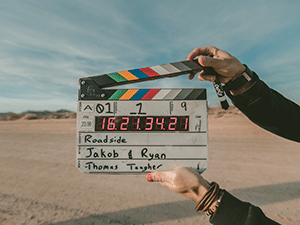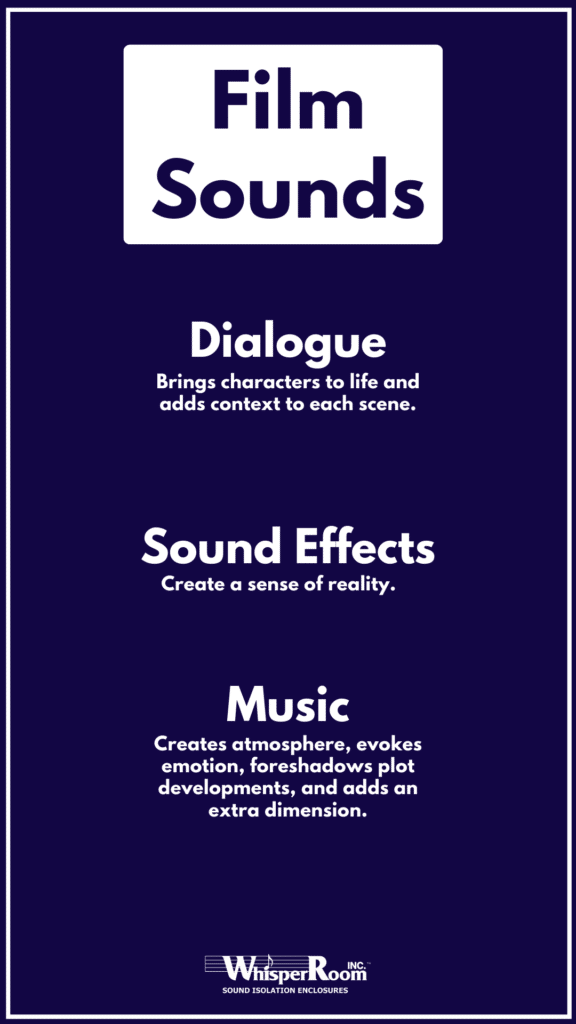Film Sounds: The Noise of Video Production
By: WhisperRoom™
June 9, 2020


The audio of video production is just as important as the visual component, if not more so. Film sounds add context to the visuals and help inform viewers of what’s actually going on in a scene. When properly combined, audio and video work together to create a one-of-a-kind experience.
It’s helpful to understand all the different sounds you hear while watching videos.
Novice filmmakers, film critics, and general viewers often overlook the element of sound. So much precision goes into the subtle differences in a scene. When done well, sound design and sound effects should be indistinguishable throughout the film. A key to the power of sound design is its invisibility to the viewer.
The three essential categories of film sounds are dialogue, sound effects, and music. These three types of sound are crucial to the viewer. A film’s sound team works to create a perfect combination of these different forms of audio to hook the audience and create a memorable viewing experience. Remember, the eyes see what the ears hear.
Dialogue is a vital component of any screenplay. It brings characters to life and adds context to each scene. The dialogue explains who characters are, what they are trying to accomplish, and who they might develop into later in the story.
The audience needs to be able to hear what the actors are saying in order to understand important plot points and to know what’s going on in the film. As a story line evolves, viewers become emotionally attached to characters because of what they do and say.
Sound effects are another important element of television shows, movies, and feature films. Modern recording technology and editing software have changed sound effects production into a booming industry.
You can hear sound effects on the radio, in podcasts, movies, video games, theater, films, and TV. These important sounds help guide the audience to believe what they are seeing and anticipate the expected – or unexpected. For example, something as simple as the doorbell ringing while a family is eating around the dinner table or a car engine struggling to start will provide clues of what might happen next.
In many instances, several subtle sound effects are happening simultaneously during a scene. This creates a sense of reality. Background conversation, the sound of lockers clanging in the hallway, overhead announcements, and a school bell ringing might be noises you hear during a scene at school.
As expected, the recordings of authentic sounds are usually more realistic than stock sound effects. The production team can edit or enhance real sounds by adjusting the pitch, volume, and intensity.

Traditionally, sound effects are cut to a film and Foley effects are performed along with the picture. Sound FX Editors make the complex sounds like machine-gun fire and computer noises while Foley artists focus on realistic footsteps, movements, and specific props.
In post-production, the Foley artists will record realistic footsteps along to the film. These experienced professionals typically record in a Foley pit and have hundreds of props on hand to help them achieve whatever sound is needed for the project.
Capturing movement is another important aspect of the Foley artist. They are responsible for creating realistic noises that synchronize with characters’ movements. A dog rolling around in leaves, a jacket zipping, and a warrior putting on heavy battle armor are all examples of noises made by the Foley team.
There are specific props that Foley artists are responsible for creating sounds for. These props tend to be items that the characters interact with, like a magazine being loaded into a gun, the sound of a hammer hitting a nail, or a vehicle’s door being slammed shut.
The importance of a film’s music is often unnoticed by the viewers, but it greatly adds to the experience. For years, soundtracks and scores have played a huge part in film and television. Music creates an atmosphere, evokes emotion, foreshadows plot developments, and adds an extra dimension to the audible part of a film. According to George Lucas, “…sound and music are 50% of the entertainment in a movie.”
The music you hear in a film is either part of the score or the soundtrack. A score is specifically written to accompany the film while a soundtrack is a collection of previously recorded songs. Both are used in film and television. With a little bit of luck and a lot of planning, the right song at the right time can create an iconic cinematic moment.
Watch this video to see how music can change how your brain perceives a film.
Diegetic and non-diegetic sounds comprise the sound design for every TV show, Hollywood movie, and video production that you watch.
Diegetic sound is any noise whose source is visible on-screen or is implied to be present by the action of the film. These sounds can either be on-screen or off-screen depending if its source is in the shot or not.
Alternatively, non-diegetic sound is any noise whose source is not visible on the screen and is not implied to be present in the action of the film. These sounds are represented as noises that come from outside the story.